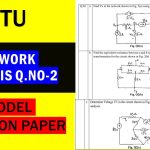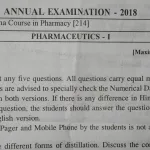The Pharm D 5th year curriculum covers advanced pharmacy topics. Reviewing previous question papers is crucial for exam preparation, helping students understand question patterns and key concepts. Below are comprehensive questions and answers for various subjects in the Pharm D 5th year.
Clinical Pharmacokinetics and Pharmacotherapeutic Drug Monitoring
Question: What is the importance of pharmacokinetics in drug therapy?
Answer: Pharmacokinetics helps determine the appropriate dosage, frequency, and route of administration to achieve optimal therapeutic effects while minimizing toxicity.
Question: Define bioavailability and its significance.
Answer: Bioavailability is the fraction of an administered drug that reaches systemic circulation. It is crucial for assessing drug efficacy.
Question: Explain volume of distribution and its clinical relevance.
Answer: Volume of distribution indicates the extent to which a drug distributes into body tissues. It helps in determining loading doses.
Question: What factors affect drug clearance?
Answer: Drug clearance is influenced by liver metabolism, kidney excretion, and factors like age, weight, and disease state.
Question: How is half-life calculated, and why is it important?
Answer: Half-life is calculated using the formula t1/2 = 0.693/ke. It helps in determining dosing intervals.
Question: Describe therapeutic drug monitoring (TDM).
Answer: TDM involves measuring drug concentrations in blood to ensure efficacy and avoid toxicity, especially for drugs with narrow therapeutic windows.
Question: What is the difference between first-order and zero-order kinetics?
Answer: First-order kinetics means the drug elimination rate is proportional to its concentration, whereas zero-order kinetics implies a constant elimination rate.
Question: Why is steady-state concentration important in drug therapy?
Answer: Steady-state concentration ensures consistent therapeutic effects and is achieved after multiple dosing intervals.
Question: Discuss the role of protein binding in drug pharmacokinetics.
Answer: Protein binding affects drug distribution, metabolism, and excretion. Only free drugs can exert therapeutic effects.
Question: What is the significance of renal clearance in pharmacokinetics?
Answer: Renal clearance determines the extent of drug elimination through the kidneys and is critical for dose adjustments in renal impairment.
Question: Explain the concept of a loading dose.
Answer: A loading dose rapidly achieves the desired drug concentration in the body, especially for drugs with long half-lives.
Question: What is the therapeutic index?
Answer: The therapeutic index is the ratio of the toxic dose to the effective dose, indicating drug safety.
Question: How do age and liver function affect drug metabolism?
Answer: Age and liver function impact enzyme activity, influencing drug metabolism rates and potential toxicity.
Question: What is the role of cytochrome P450 enzymes in drug metabolism?
Answer: Cytochrome P450 enzymes metabolize drugs, influencing their pharmacokinetics and interactions.
Question: Define pharmacodynamic variability and its causes.
Answer: Pharmacodynamic variability refers to differences in drug effects among individuals due to genetic, physiological, and pathological factors.
Question: Why is drug monitoring essential for aminoglycosides?
Answer: Monitoring aminoglycosides prevents nephrotoxicity and ototoxicity due to their narrow therapeutic index.
Question: Discuss the impact of genetic polymorphism on drug therapy.
Answer: Genetic polymorphisms in drug-metabolizing enzymes can alter drug efficacy and safety.
Question: What is a pharmacokinetic drug interaction?
Answer: A pharmacokinetic drug interaction occurs when one drug affects the absorption, distribution, metabolism, or excretion of another drug.
Question: How is drug accumulation calculated?
Answer: Drug accumulation is calculated using the formula Accumulation Factor = 1 / (1 – e^(-ke × dosing interval)).
Pharmacovigilance
Question: Define pharmacovigilance.
Answer: Pharmacovigilance is the science of detecting, assessing, and preventing adverse drug reactions (ADRs).
Question: What are the common methods for reporting ADRs?
Answer: ADRs are reported through spontaneous reporting systems, prescription event monitoring, and electronic health records.
Question: Why is pharmacovigilance important in clinical practice?
Answer: Pharmacovigilance ensures drug safety by identifying risks and minimizing harm to patients.
Question: What are the different types of ADRs?
Answer: ADRs are classified as Type A (predictable) and Type B (unpredictable).
Question: Explain the role of the WHO in pharmacovigilance.
Answer: The WHO coordinates global pharmacovigilance efforts, providing guidelines and maintaining the ADR database.
Question: What is a signal in pharmacovigilance?
Answer: A signal is information that suggests a new or known drug-related risk requiring further investigation.
Question: How does spontaneous reporting help in pharmacovigilance?
Answer: Spontaneous reporting helps identify rare and unexpected ADRs, enhancing drug safety.
Question: What are the challenges in pharmacovigilance?
Answer: Challenges include underreporting, data quality issues, and limited resources for monitoring.
Question: How are ADRs assessed for causality?
Answer: ADRs are assessed using algorithms like Naranjo’s scale or WHO-UMC criteria.
Question: What is the role of regulatory agencies in pharmacovigilance?
Answer: Regulatory agencies monitor ADRs, enforce reporting requirements, and ensure drug safety compliance.
Question: What is the importance of post-marketing surveillance?
Answer: Post-marketing surveillance identifies long-term and rare ADRs that clinical trials might miss.
Question: Define risk management plan (RMP).
Answer: An RMP outlines strategies to identify, assess, and minimize drug risks throughout its lifecycle.
Question: How is data mining used in pharmacovigilance?
Answer: Data mining identifies patterns and signals in large pharmacovigilance databases to detect potential ADRs.
Question: What are black box warnings?
Answer: Black box warnings highlight serious or life-threatening ADRs associated with a drug.
Question: What is the Yellow Card Scheme?
Answer: The Yellow Card Scheme is the UK’s system for reporting ADRs and drug safety concerns.
Question: Discuss the importance of patient education in pharmacovigilance.
Answer: Patient education promotes awareness of ADRs and encourages timely reporting, enhancing drug safety.
Question: What is the role of healthcare professionals in pharmacovigilance?
Answer: Healthcare professionals report ADRs, educate patients, and ensure safe drug use.
Question: Define adverse drug event (ADE).
Answer: An ADE is any undesirable occurrence associated with drug use, whether or not it is causally related.
Question: What is the difference between ADR and side effect?
Answer: An ADR is harmful and unintended, while a side effect can be any secondary effect, whether harmful or beneficial.
Clinical Pharmacy
Question: What is the role of a clinical pharmacist?
Answer: A clinical pharmacist optimizes drug therapy, ensures patient safety, and provides medication-related education.
Question: Define pharmaceutical care.
Answer: Pharmaceutical care involves the responsible provision of drug therapy to achieve specific health outcomes.
Question: What is a drug utilization review (DUR)?
Answer: A DUR assesses the appropriateness, safety, and effectiveness of drug use.
Question: How is medication adherence measured?
Answer: Medication adherence is measured through methods like pill counts, pharmacy refill records, and patient interviews.
Question: What is a medication reconciliation process?
Answer: Medication reconciliation ensures consistency in medication information during patient transitions between care settings.
Question: Define clinical trial phases.
Answer: Clinical trials have four phases: Phase I (safety), Phase II (efficacy), Phase III (comparison), and Phase IV (post-marketing).
Question: What is the significance of patient counseling?
Answer: Patient counseling improves medication adherence, ensures proper drug use, and prevents errors.
Question: Explain the concept of drug interactions.
Answer: Drug interactions occur when one drug affects the action of another, potentially altering efficacy or safety.
Question: What is the difference between compliance and concordance?
Answer: Compliance is following prescribed therapy, while concordance involves shared decision-making between patient and provider.
Question: What is the role of therapeutic guidelines?
Answer: Therapeutic guidelines provide evidence-based recommendations for disease management.
Question: How is patient confidentiality maintained in clinical pharmacy?
Answer: Patient confidentiality is maintained by safeguarding medical records and sharing information only with authorized personnel.
Question: Define pharmacoeconomics.
Answer: Pharmacoeconomics evaluates the cost-effectiveness of drugs and therapies to optimize healthcare resources.
Question: What are the types of medication errors?
Answer: Medication errors include prescribing, dispensing, administration, and monitoring errors.
Question: Discuss the importance of adverse drug reaction (ADR) reporting.
Answer: ADR reporting helps identify unsafe drugs, improves patient safety, and enhances pharmacovigilance.
Question: What is the importance of dose adjustment in renal impairment?
Answer: Dose adjustment prevents drug accumulation and toxicity in patients with reduced renal function.
Question: Define polypharmacy and its risks.
Answer: Polypharmacy is the use of multiple medications, increasing the risk of interactions and ADRs.
Question: What is the significance of evidence-based medicine (EBM)?
Answer: EBM integrates clinical expertise, patient values, and research evidence for optimal decision-making.
Question: Explain the concept of patient-centered care.
Answer: Patient-centered care focuses on individual patient needs, preferences, and values in clinical decisions.
Question: What is a formulary, and why is it important?
Answer: A formulary is a list of approved drugs, ensuring cost-effective and evidence-based medication use.
Question: What is the importance of deprescribing?
Answer: Deprescribing reduces inappropriate medications, minimizing adverse effects and optimizing therapy.
In-depth preparation with a focus on previous question papers helps Pharm D students succeed in their exams. Understanding these key concepts ensures readiness and builds a strong foundation for professional practice.
Latest Posts
- Step-by-step guide to download and apply for jee mains admit card 202
- Comprehensive 2025 government holidays and recruitment details for job seekers
- JEE Mains Admit Card 2025: Your Step-by-Step Guide to Downloading the Hall Ticket
- Everything You Need to Know About 2025 Government Holidays Recruitment
- Comprehensive Guide to rrb d group recruitment 2025 – Eligibility, Vacancies, and Application
- Detailed guide to nps trust recruitment 2025 vacancies, eligibility and apply process
- Comprehensive guide to hpcl recruitment 2025 notification, vacancies, and application process
- ignou bed admission 2025 complete recruitment guide with eligibility and process
- Comprehensive Guide to Indian Army Agniveer Recruitment 2025 Notification and Jobs
- Everything You Must Know About CBSE Board Exams 2025 Changes & New Rules






